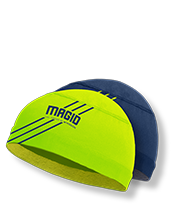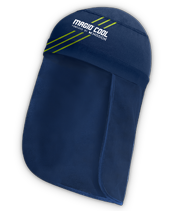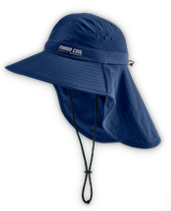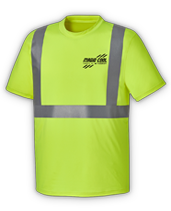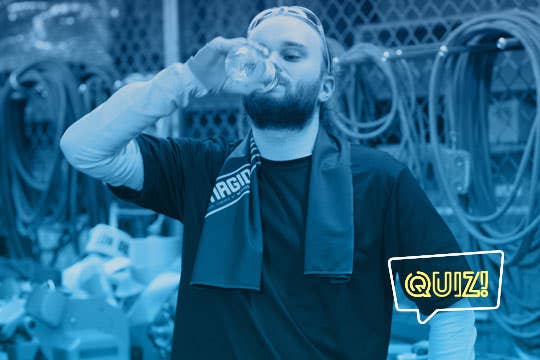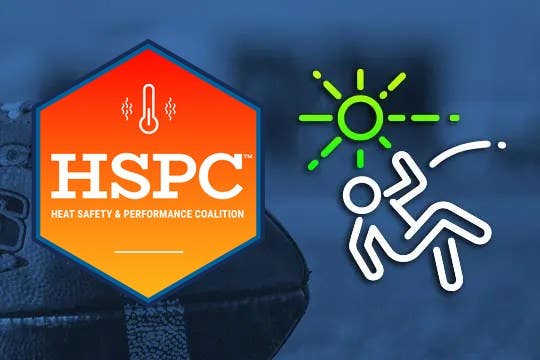
Heat Exhaustion & Heat Stroke: What Workers Can Learn from Sports
By M.B. Sutherland, Sr. Safety Writer, Magid
Korey Stringer was a talented young athlete in the early days of pre-season football practice for the Minnesota Vikings. Although he was a five-year pro-football veteran, used to the rigors of practice and working in the heat, he suffered exertional heat stroke and passed away in the hospital a day later from multiple organ failure.
Determined to honor his legacy and ensure that his death would help others avoid the same fate, his widow Kelci Stringer worked to help found the Korey Stringer Institute (KSI) at the University of Connecticut to further research and understanding of heat illness prevention and recovery.
We sat down with Margaret Morrissey, Director of Occupational Safety at KSI and President of the recently formed Heat Safety & Performance Coalition (HSPC) (formerly the National Heat Safety Coalition)—an alliance including Magid Glove & Safety, KSI, and textile manufacturer Mission, that aims to eliminate heat-related injuries and illnesses in the workplace—to talk about what they’ve learned from working in sports that can help industrial athletes stay safer in hot conditions. She outlined some significant lessons that translate to anyone working in the heat. Please note that we’ve changed the names of the players to pseudonyms in these cases.


LESSON #1: Acclimate Your Workers to the Heat Over Time
Both athletes and industrial workers alike need to get their bodies used to working in the heat by spending just a couple of hours a day exerting themselves at first. Then, add time each day for a week or two – so that might mean working two hours on days one and two, three hours on days three and four, etc. This causes actual physiological changes in the body like increased sweating and a slightly lower heart rate that help to keep the body cooler.
But keep in mind that heat acclimatization does not make you invincible. It helps to keep you safer, but if other important heat safety measures are ignored, heat illness is still a very real possibility.
CASE: MARTIN SULLIVAN
Martin Sullivan, a healthy, 21-year-old college basketball player, collapsed with heat stroke during a run in the heat. Players had not been acclimatized to the heat, they were not provided water, their activities were not modified based on the hot day, no one on site recognized the heat stroke symptoms he was showing, and he was transported to the hospital without effective body cooling. Other players tried to help by dumping water on him in an effort to cool him down, but it fell far short. Sullivan died in the hospital twelve days later.
Heat Safety Lessons:
- Perform Heat Acclimatization
- Alter Work-to-Rest Ratios
- Know the Signs of Heat Illness
- Hydrate Properly
- Cool First, Transport Second
In Sullivan’s case, just about everything that could go wrong did. This was a classic case of lack of understanding and preparation with tragic consequences and it’s a situation repeated on too many job sites. “A lot of the coaches, they don’t know what the dangers of heat are,” Morrissey said. “Same with safety managers. Many are focused on how to be more productive, but forgetting that it can come at a cost.”


LESSON #2: Heat Stroke Can Have Long-Term Consequences
Morrissey said that survivors of exertional heat illness may come into the KSI lab for Heat Tolerance Testing to make sure they’re ready to return to their sport. For many, they find that the damage done by heat stroke makes them unable to exert themselves in the heat. She said that some take many months to fully recover, while others find that they can never return to playing sports or working in the heat again. If they were cooled properly within 30 minutes, they stand an excellent chance of surviving with no complications. If they aren’t, the outcomes can be much more tragic.
CASE: JASON BAILEY
Jason Bailey was a 19-year-old college baseball player who collapsed from heat stroke during his first baseball practice of the year. The team held a four-hour practice in 96-degree heat including running and tire drills, with no water breaks. Bailey was in the batting cages when he collapsed and was found to have a 106-degree internal body temperature by the time he reached the hospital. He needed emergency surgery to relieve pressure on his brain and spent weeks in the hospital followed by three months of rehabilitation to be able to resume normal life.
Heat Safety Lessons:
- Perform Heat Acclimatization
- Alter Work-to-Rest Ratios
- Hydrate Properly
- Cool First, Transport Second
In this case, players were educated about hydration and heat illness and the coach did begin cooling Bailey with ice bags while they called 911, but the team had not acclimated to the heat before holding that long practice and they stopped cooling him once the ambulance arrived. Much like an industrial worker’s first day on a hot job, his body was not prepared to handle hours of exertion at such a high temperature. The coach should have held shorter practices for a week or two and provided cool drinking water and electrolyte-replacing beverages at all times. Perhaps most importantly, the coach should have finished adequately cooling Bailey before he was loaded into the ambulance.
How to Treat a Heat Stroke
When someone suffers a heat stroke, you have just 30 minutes to get their core temperature down to normal levels before permanent organ damage begins. Dr. Douglas Casa, CEO of KSI, explains that many heat stroke victims suffer permanent damage in the ambulance on the way to the hospital because rescuers didn’t know to cool first, and transport second. The gold standard treatment for heat stroke is to immerse the victim in a tub of cold water and continually add cold water and ice until their temperature normalizes. A possible substitute for this, if a cooling tub is not possible in the environment, is to use a tarp as a makeshift tub. Put the victim in the center of the tarp, lift the sides to make a kind of sling, add cold water and ice, and immerse them as well as you can while you wait for EMTs.


LESSON #3: Know Heat Illness Symptoms & Don't Rely on Subjective Measures of Heat Risk
According to Morrissey, people will sometimes depend on workers to engage in what they call self-pacing. “They think if you self-pace the work, you’re going to be better off and you won’t suffer from heat illness or have negative outcomes.” But in reality, she says workers don’t self-pace safely because they’re focused on trying to get the job done. “For example, a farm worker who is paid on a piece pay system. The employer says, ‘Take your time, you’ll be safer from the dangers of heat.’ But really, they’re getting paid by how much they do, so that doesn’t apply. You need to have organizational-level, specific heat safety protocols and not expect everyone to look out for each other. The buddy system is great, but you can’t rely on that!” You would never tell your workers to handle sharp materials without training and PPE and simply ask them to be careful. The same should be true of heat protection.
CASE: THOMAS HILL
A 19-year-old offensive lineman in college football, Thomas Hill completed his second day of conditioning drills in 81-degree weather with 65% humidity. He suffered a heat stroke and passed away the same day.
Heat Safety Lessons:
- Heat Illness Can Happen Even on Warm Days
- Self-Monitoring is Not Reliable
With enough physical exertion, heat illness can happen even on what many people would consider to be a mildly warm day. In fact, these days can be particularly dangerous because it’s easy for workers and players alike to think they’re safe because it doesn’t seem that hot out. As the person continues to work, heat can build up in the body and even a well-hydrated person will succumb to heat illness and even heat stroke if they can’t shed the heat faster than they’re accumulating it.
Heat Safety Wearable Technologies
Morrissey said that many safety managers are excited about this concept, but warns that we’re not there yet. “I think we’ll get there at some point. But the research just isn’t there in terms of using it as a safety threshold. As much as it would be an easy solution for safety managers to give their workers a watch and look at their heart rate, we need to make sure if you want to utilize physiological monitoring, you’re doing it in conjunction with looking at the environment and making work-to-rest ratios based on that. We’re hoping at the Korey Stringer Institute to validate these wearables. But there’s a couple more steps that have to happen before we get there.”
LESSON #4: Know Your Heat Stroke Facts and Use Your Lifesaving Tools
CASE: JOSHUA MALLOY
A college sophomore and football offensive lineman, Joshua Malloy was participating in conditioning tests including running sprints. The 19-year-old young man overheated and began having convulsions. Rather than calling 911, medical staff walked him around in an attempt at “active-recovery,” bringing him farther away from life-saving equipment. He was later hospitalized and died from heat stroke complications the same night.
Heat Safety Lessons:
- Know the Signs of Heat Illness
- Don’t Be Afraid to Use Life Saving Tools
Morrissey explained that the tragedy here was compounded by the fact that the team did have an immersion tub available that they could have put Malloy into, almost certainly saving his life. In another example, Morrissey related a similar story of a group of medical professionals who were standing over a heat stroke victim at a road race arguing whether they should put him in a cooling tub because he had experienced a minor cardiac event in the past. She said the idea that someone may have a cardiac event when immersed in cold water is a common misperception and that there is no evidence for it. In this case, they were able to treat the runner and he recovered.
LESSON #5: Provide Quality Body Cooling PPE
Morrissey said she sees many organizations trying to get away with using cheaper body cooling gear that they often use in the wrong way. If you have a cooling towel that doesn’t inherently stay cool, you’ll need to continuously dip it in cold water or “you’re essentially putting a hot rag on yourself.” She said that a group of athletes experimented with putting wet towels on their arms without refreshing the cold temperature. They found that, either their core temperature stayed the same, or it actually went up.
A better option is cooling PPE that works with HydroActive™ Technology. This technology is activated by adding water of any temperature (even very hot water), wringing the excess water out, and then snapping the garment in the air. The fiber weave harnesses natural evaporation to bring the garment’s temperature down as low as 30 degrees below average body temperature, and it stays cool for up to 2 full hours. This provides far superior cooling for athletes and workers than a towel that constantly needs cold water refreshment.
Magid® Cool Powered by Mission® Cooling Gear
LESSON #6: Remember that Heat Exhaustion Can Happen to Anyone
Morrissey summed up her many pieces of good advice by reminding us that we can’t predict who will suffer from heat stroke or how severely it will affect them. She said her experience with heat illness survivors at KSI span from elite athletes to those who were inactive. “It opened my eyes that it’s not just one category. Everyone is susceptible.”


